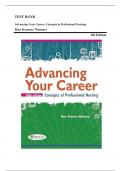TEST BANK
Advancing Your Career: Concepts in Professional Nursing
Rose Kearney Nunnery
5th Edition
M
ED
C
O
N
N
O
IS
SE
U
R
,Chapter 1. Your Professional Identity
Multiple Choice
Identify the choice that best completes the statement or answers the question.
M
____ 1. Which of the following is not a characteristic of a profession?
A. Authority
B. Leadership
C. Systematic theory
ED
D. Professional culture
____ 2. The definition by Kerlinger and Lee (2000) as a “a set of interrelated constructs (concepts), definitions, and
propositions that present a systematic view of phenomena by specifying relations among variables, with the
purpose of explaining and predicting the phenomena” is a:
A. Systems theory
C
B. Profession
C. Key concept
D. Theory
O
____ 3. The correct definition of a paradigm used by professionals in a scientific community consists of the belief
system shared by members of that particular community and includes:
A. Conducting research, phenomena, and practicing the profession
N
B. The code of ethics, the practice of the profession, and conducting research
C. Practice of the profession, conducting research, and the standards of practice
D. Evidence-based practice, practice of the profession, and conducting research
N
____ 4. Which of the following is not one of the five competencies for a health-care professional?
A. Evidence-based practice
B. Continuing education
O
C. Patient-centered care
D. Informatics
____ 5. The spiritual, emotional setting(s) or climate in which the person lives, plays, and interacts as well as the
IS
social, physical setting describes:
A. A patient
B. A profession
C. An ethical code.
SE
D. An environment
____ 6. Which of the following is not a main concept of a metaparadigm?
A. Human beings
B. Theory
C. Health
U
D. Nursing
____ 7. Which of the following does the code of ethics for nurses not address?
A. Behavior with medical professionals
R
B. Behavior with clients
C. Behavior with colleagues
D. Behavior with patient advocates
____ 8. Which of the following is not part of the Standards of Professional Performance?
, A. Systemic theory
B. Education
C. Communication
D. Leadership
____ 9. The judgment and self-governing within one’s scope of practice is part of:
M
A. Evidence-based practice
B. Knowledge base
C. Code of ethics
D. Leadership
ED
True/False
Indicate whether the statement is true or false.
____ 1. A philosophy of nursing is the medical profession’s belief system.
C
____ 2. The professional nurse is concerned with safe and effective care beyond the treatment facility with such
things as the environment, health, and human beings.
O
____ 3. Community sanction occurs through rules and regulations, expectations for practitioners, and professional
code of ethics.
N
____ 4. Informal groups exist within each formal group, providing further professional collegial inclusiveness.
____ 5. Continuing education is not part of the code of ethics.
N
O
IS
SE
U
R
, ____ 6. Evidence-based practice is the separation of clinical expertise and rules and regulations.
Chapter 1. Your Professional Identity
Answer Section
MULTIPLE CHOICE
M
1. ANS: B
Leadership is not one of the five characteristics of a profession, which include (1) systematic theory and
knowledge base, (2) authority, (3) community sanction, (4) an ethical code, and (5) a professional culture.
ED
PTS: 1 DIF: Level 1 TOP: Professional Identity
2. ANS: D
Kerlinger and Lee’s definition of theory is “a set of interrelated constructs (concepts), definitions, and
propositions that present a systematic view of phenomena by specifying relations among variables, with the
purpose of explaining and predicting the phenomena.”
C
PTS: 1 DIF: Level 1 TOP: Professional Identity
3. ANS: A
O
Conducting research, phenomena, and practicing the profession are part of the definition of a paradigm.
PTS: 1 DIF: Level 1 TOP: Professional Identity
N
4. ANS: B
Continuing education is not one of the five core competencies for health professionals. They are for all health
professionals is to advance a vision for the education of all health professionals, to deliver patient-centered
care as members of an interdisciplinary team, emphasizing evidence-based practice, quality improvement
N
approaches, and informatics.
PTS: 1 DIF: Level 1 TOP: Professional Identity
O
5. ANS: D
The environment comprises the physical, social, cultural, spiritual, and emotional climate or setting(s) in
which the person lives, works, plays, and interacts.
IS
PTS: 1 DIF: Level 1 TOP: Professional Identity
6. ANS: B
Theory is not included in the four concepts of metaparadigm, which are human beings, environment, health,
SE
and nursing.
PTS: 1 DIF: Level 1 TOP: Professional Identity
7. ANS: D
Developed within the profession, the code of ethics addresses general ethical practice issues as well as
professional, personal, and practice values and colleague relationships. It does not refer to the need for health
U
professionals to be patient advocates.
PTS: 1 DIF: Level 1 TOP: Professional Identity
R
8. ANS: A
Systemic theory is not one of the standards of professional performance, which are expected professional
roles and behaviors, including ethics, education, evidenced-based practice and research, quality of practice,
communication, leadership, collaboration, professional practice evaluation, resource utilization, and
environmental health.




